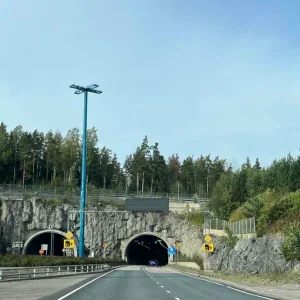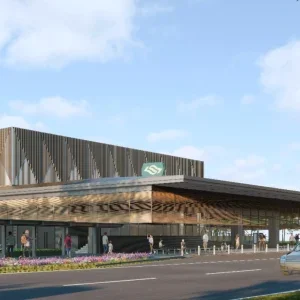Divers working blind in seven bar pressure of bentonite slurry have allowed two stalled TBMs to restart on the Netherlands, Westerschelde crossing.
Experienced North Sea oilfield divers carried out the "saturation" diving operations, which, at nearly 7 bar, are claimed to be a world record. Divers were ferried in a special four-man capsule from a pressurised surface residence station to the TBM’s bentonite slurry cutterhead where they entered the pressure chamber through airlocks.
Decompression periods made it necessary to adopt "continuous" pressurised operations for which all equipment had been installed as a precaution. The operation for each TBM necessitated the divers living for about two weeks under pressurised conditions.
The main work of the divers was to replace peripheral cutters with 12 larger models on each TBM in an effort to maintain a larger annulus.
Both 11.34m-diameter Herrenknecht Mixshield TBMs had been halted by poor progress rates in apparently "squeezing" ground which had reportedly deformed the shield cans slightly, with consequent steering and lining erection problems.
The two were progressing from a reclaimed "polder" at Terneuzen on the south bank of the River Westerschelde to receiving caissons at Ellewoutsdijk on the north side. They had reached the deepest point of the 6.6-km runs. The predicted ground for tunnelling is chiefly clayey sand in the centre, but with glauconitic sand towards the end of the drive, and also below the clayey sand at the deepest point.
At the halt position a slurry pressure of around 6.5 bar was necessary in order to maintain face stability. The system is designed to work at up to 8.5bar to allow sufficient for work at up to 65m depth below the river estuary.
As with other Mixshields, a compressed air bubble in the pressure chamber provides a better response time to changing ground conditions. A further ground-control precaution are five hydraulically operated forepoling plates in the face crown.
The divers not only replaced cutters but also installed plastic lifter-bags around each distorted shield. These were inflated with water to push back the soft ground, and then deflated to leave an annulus, allowing the TBM to move more freely and restart forward progress.
Also under consideration was an untested segment reshaper. It was felt too expensive and risky to use on this occasion. The equipment would have to be operated for each ring, to give an expected forward progress of 6m/day under perfect operation.
The work took six working days for each machine excluding decompression. The west machine was refurbished in mid-June and the other last month (August).
Seven-piece pre-cast concrete rings with interlocking segments and gaskets are being installed within each TBM shield.
TBM progress to date has been 600m for the east bore and 500m for the west side. The delays lasted nearly six months but now both TBMs are said to be advancing steadily at 6-8m/day. Hydraulic lifting bags no longer have to be used.
The joint venture, KMW, has a design-and-construct contract which includes a maintenance agreement for the first ten years of tunnel crossing operation. The crossing was originally scheduled for opening in March 2003, following the completion of tunnel boring in autumn 2001. Project cost was budgeted at $725M.
Related Files
Location Map
Location Map – Detail







